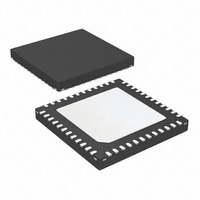AT89C5131A-PLTIL Atmel, AT89C5131A-PLTIL Datasheet - Page 102

AT89C5131A-PLTIL
Manufacturer Part Number
AT89C5131A-PLTIL
Description
IC 8051 MCU FLASH 32K USB 48QFN
Manufacturer
Atmel
Series
AT89C513xr
Specifications of AT89C5131A-PLTIL
Core Processor
C52X2
Core Size
8-Bit
Speed
48MHz
Connectivity
I²C, SPI, UART/USART, USB
Peripherals
LED, POR, PWM, WDT
Number Of I /o
34
Program Memory Size
32KB (32K x 8)
Program Memory Type
FLASH
Eeprom Size
4K x 8
Ram Size
1.25K x 8
Voltage - Supply (vcc/vdd)
3 V ~ 3.6 V
Oscillator Type
Internal
Operating Temperature
-40°C ~ 85°C
Package / Case
48-VQFN Exposed Pad, 48-HVQFN, 48-SQFN, 48-DHVQFN
For Use With
AT89STK-10 - KIT EVAL APPL MASS STORAGEAT89STK-05 - KIT STARTER FOR AT89C5131
Lead Free Status / RoHS Status
Contains lead / RoHS non-compliant
Data Converters
-
Other names
AT89C5131-PLTIL
- Current page: 102 of 186
- Download datasheet (2Mb)
Master Transmitter Mode
Master Receiver Mode
102
AT89C5131A-L
A: Acknowledge bit (low level at SDA)
A: Not acknowledge bit (high level at SDA)
Data: 8-bit data byte
P : STOP condition
In Figure 52 to Figure 55, circles are used to indicate when the serial interrupt flag is set.
The numbers in the circles show the status code held in SSCS. At these points, a ser-
vice routine must be executed to continue or complete the serial transfer. These service
routines are not critical since the serial transfer is suspended until the serial interrupt
flag is cleared by software.
When the serial interrupt routine is entered, the status code in SSCS is used to branch
to the appropriate service routine. For each status code, the required software action
and details of the following serial transfer are given in Table to Table 85.
In the master transmitter mode, a number of data bytes are transmitted to a slave
receiver (Figure 52). Before the master transmitter mode can be entered, SSCON must
be initialised as follows:
Table 77. SSCON Initialization
CR0, CR1 and CR2 define the internal serial bit rate if external bit rate generator is not
used. SSIE must be set to enable TWI. STA, STO and SI must be cleared.
The master transmitter mode may now be entered by setting the STA bit. The 2-wire
logic will now test the 2-wire bus and generate a START condition as soon as the bus
becomes free. When a START condition is transmitted, the serial interrupt flag (SI bit in
SSCON) is set, and the status code in SSCS will be 08h. This status must be used to
vector to an interrupt routine that loads SSDAT with the slave address and the data
direction bit (SLA+W).
When the slave address and the direction bit have been transmitted and an acknowl-
edgement bit has been received, SI is set again and a number of status code in SSCS
are possible. There are 18h, 20h or 38h for the master mode and also 68h, 78h or B0h if
the slave mode was enabled (AA=logic 1). The appropriate action to be taken for each
of these status code is detailed in Table . This scheme is repeated until a STOP condi-
tion is transmitted.
SSIE, CR2, CR1 and CR0 are not affected by the serial transfer and are referred to
Table 7 to Table 11. After a repeated START condition (state 10h) the TWI module may
switch to the master receiver mode by loading SSDAT with SLA+R.
In the master receiver mode, a number of data bytes are received from a slave transmit-
ter (Figure 53). The transfer is initialized as in the master transmitter mode. When the
START condition has been transmitted, the interrupt routine must load SSDAT with the
7-bit slave address and the data direction bit (SLA+R). The serial interrupt flag SI must
then be cleared before the serial transfer can continue.
When the slave address and the direction bit have been transmitted and an acknowl-
edgement bit has been received, the serial interrupt flag is set again and a number of
bit rate
CR2
SSIE
1
STA
0
STO
0
SI
0
AA
X
bit rate
CR1
4338F–USB–08/07
bit rate
CR0
Related parts for AT89C5131A-PLTIL
Image
Part Number
Description
Manufacturer
Datasheet
Request
R

Part Number:
Description:
Manufacturer:
Atmel Corporation
Datasheet:

Part Number:
Description:
Manufacturer:
Atmel Corporation
Datasheet:

Part Number:
Description:
IC 8051 MCU FLASH 32K USB 32QFN
Manufacturer:
Atmel
Datasheet:

Part Number:
Description:
IC 8051 MCU FLASH 32K USB 52PLCC
Manufacturer:
Atmel
Datasheet:

Part Number:
Description:
IC MCU 32KB 3-3.6V USB 48-VQFN
Manufacturer:
Atmel
Datasheet:

Part Number:
Description:
MCU 8051 32K FLASH USB 28-SOIC
Manufacturer:
Atmel
Datasheet:

Part Number:
Description:
IC 8051 MCU FLASH 32K USB 64VQFP
Manufacturer:
Atmel
Datasheet:

Part Number:
Description:
MCU 8051 32K FLASH USB 64-VQFP
Manufacturer:
Atmel
Datasheet:

Part Number:
Description:
MCU 8051 32K FLASH USB 28-SOIC
Manufacturer:
Atmel
Datasheet:

Part Number:
Description:
MCU 8051 32K FLASH USB 52-PLCC
Manufacturer:
Atmel
Datasheet:

Part Number:
Description:
IC 8051 MCU FLASH 32K USB 64VQFP
Manufacturer:
Atmel
Datasheet:

Part Number:
Description:
IC 8051 MCU FLASH 32K USB 32QFN
Manufacturer:
Atmel
Datasheet:

Part Number:
Description:
IC 8051 MCU FLASH 32K USB 52PLCC
Manufacturer:
Atmel
Datasheet:

Part Number:
Description:
IC 8051 MCU FLASH 32K USB 28SOIC
Manufacturer:
Atmel
Datasheet:










